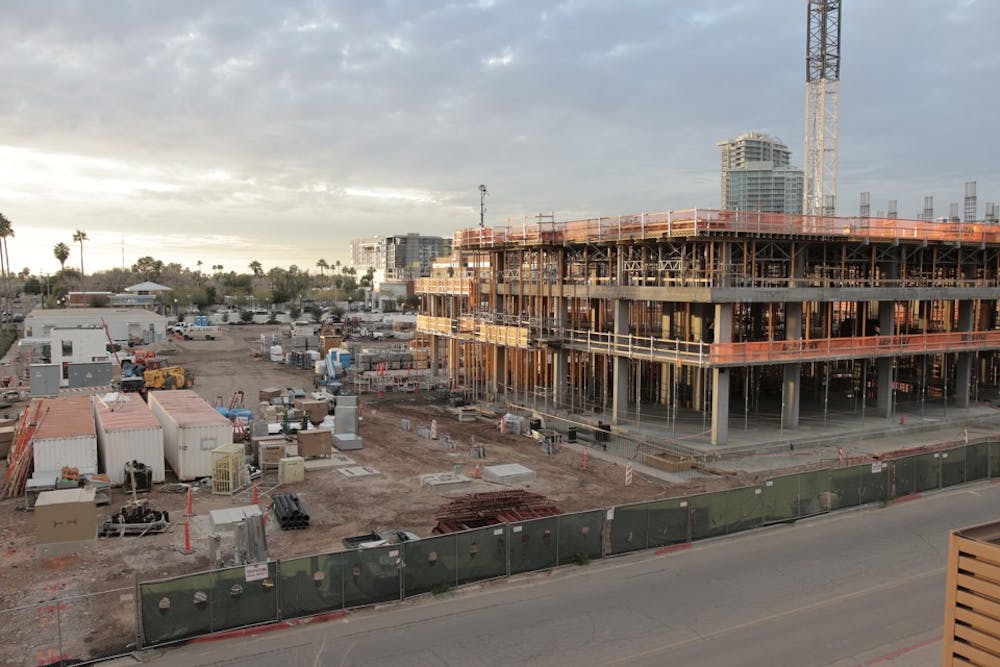Music streams through the too-thin walls of a dorm and enthusiastic yelling is heard from across the hall. The streets of Mill Avenue are bursting at the seams, with thriving businesses and scooters strewn across the pavement.
But despite its longstanding reputation as a college town, Tempe is about to welcome a new community: the elderly.
Mirabella at ASU is a retirement community that will be completed in 2020 and offer resort-style living, according to its website. In addition, the residents will be able to take classes and use campus facilities as they re-engage in the college experience — they are lifelong learners, to use the University's jargon.
Related: Retirement home on campus? A new residential community planned for ASU
Despite only being in the early stages of construction, the community is already completely sold out.
At 20 stories tall, the community will include a theater, indoor pool, art museum and spa. At the groundbreaking ceremony in February 2018, ASU President Michael Crow dubbed the community “the world’s coolest dorm” and said that there is no reason the area surrounding the Tempe campus should exclude any particular age group, as reported by KJZZ.
David King, an assistant professor in the School of Geographical Sciences and Urban Planning, said that building a retirement community in the heart of a college town is a "clever idea."
"What you have is a retirement community right next to a vibrant walkable downtown campus area," King said. "Where else can you be adjacent to a lovely place to walk around? The more you think about it the more you wonder why more colleges aren't doing this."
King said that a potential issue in building so close to a college campus is differing ideas in what qualifies as entertainment between the two age groups.
Mirabella at ASU residents will be 62 and older, with the facility offering assisted-care living, nursing suites and a memory-care section.
Deborah Hall, an associate professor at the School of Social and Behavioral Sciences, said the joining of two communities could lead to benefits for both the younger and older people.
“I think there will be challenges in the beginning, and then there will be challenges that crop up later, but overall, the benefits would far outweigh a lot of the challenges,” she said.
Hall said that general misunderstandings between the age groups could initially impact their impressions of one another, but living in a joined space would help them see through the stereotypes.
“I do think something that may come up is the difference in lifestyles between age groups," she said. "There are very different day-to-day routines for younger students and retirees, even coming down to the amount of rest they need.”
And such an arrangement could help to remedy the social isolation that the elderly can feel, said Ramona Lewis, a faculty member in educational leadership at Western Michigan University who specializes in older learners.
"Continuing to have opportunities to stay engaged is super important," she said.
But there are some reasons for concern. On one hand, Lewis said, the price can be exclusive, highlighting a disparity between the aging poor and aging wealthy.
"I do want to point out that retirement communities such as these are serving the wealthy," Lewis said. "Projects like this exist all over the country, and they really show that there's this disparity in how the rich are growing old and how the poor are growing old."
The cost for reach unit ranges from $378,500 to $812,200. The majority of this price is refunded to the heirs of the residents upon their deaths, but there's still a monthly fee as high as $5,570. That said, growth in median income for those 65 and older has far outpaced other age groups.
There's also the prospect of several thousand 20-somethings not being enthused with the sudden arrival of a building full of retirees. One student, Sarah Grom, a junior studying psychology, said she's hesitant about the integration of retirees with young students.
“Honestly, I worry they’ll think the area is too loud," Grom said. "When it comes down to it, Tempe is a college town, and I think the kind of activities and shops down here really reflect that."
She said she saw irony in the development because her dad, an ASU alumnus, recently joked about wanting to live on campus again.
Though students have expressed some concerns, Hall said the only way to know what it will really be like is to live it.
“I think it’ll be a great way to overcome and challenge previous stereotypical beliefs they might have with one another," she said. "Building those relationships can really have a great impact in bringing different types of people together.”
Reach the reporter at kreinha3@asu.edu and follow @ReinhartKatelyn on Twitter.
Like The State Press on Facebook and follow @statepress on Twitter.




